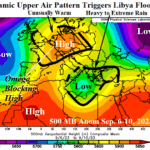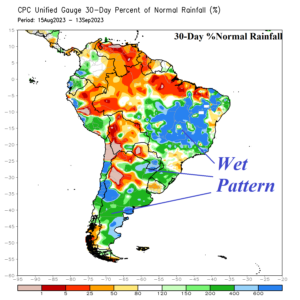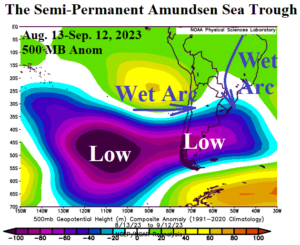
Omega Block + Marine Heatwave = Libya Flooding
09/12/2023, 3:47 pm EDTPattern Reversal: Amundsen Sea Trough Replaced by Ridge; Teleconnection to Brazil is Hot/Dry Ridge
09/18/2023, 5:12 am EDT



Fig. 1-4: The wet 30-day pattern across South America and due to the rain, the changed soil moisture conditions all related to expansion of the Amundsen Sea trough which is semi-permanent since 2020.
Discussion: During the past 30 days a wet climate has emerged across Brazil, Chile, and eastward across Central Argentina (Fig. 1). The wet pattern was somewhat unexpected. The rainy pattern has shifted soil moisture wetter in Central/East-central, and Southeast Brazil and eroded Chile and Argentina drought (Fig. 2). The cause of the wet weather pattern is expansion of the 2020-23 Amundsen Sea trough from home base southwest of South America northeastward to the east of Argentina during the past 30 days (Fig. 3). The upper trough has inspired a wet arc from the tropical Atlantic across Central to Southeast Brazil and into Chile. The upper trough is semi-permanent stretching from near and north of the Amundsen Sea off the Antarctic Coast to the southwest of South America (Fig. 4). During the past 3-4 years the upper trough sometimes extends northeastward to directly affect South America climate most famously causal of the Brazil coffee freeze during winter 2021.
During the past decade attention to the presence of marine heatwaves (MHW) has increased. However, there are 2 cool pools, often referred to as warm holes due to the surrounding oceanic warmth. They are the North Atlantic warm hole (NAWH) south of Greenland and the Amundsen Sea warm hole (ASWH) southwest of South America. Both cool pools are caused by increased and more rapid ice and snowmelt from poleward landmasses.
